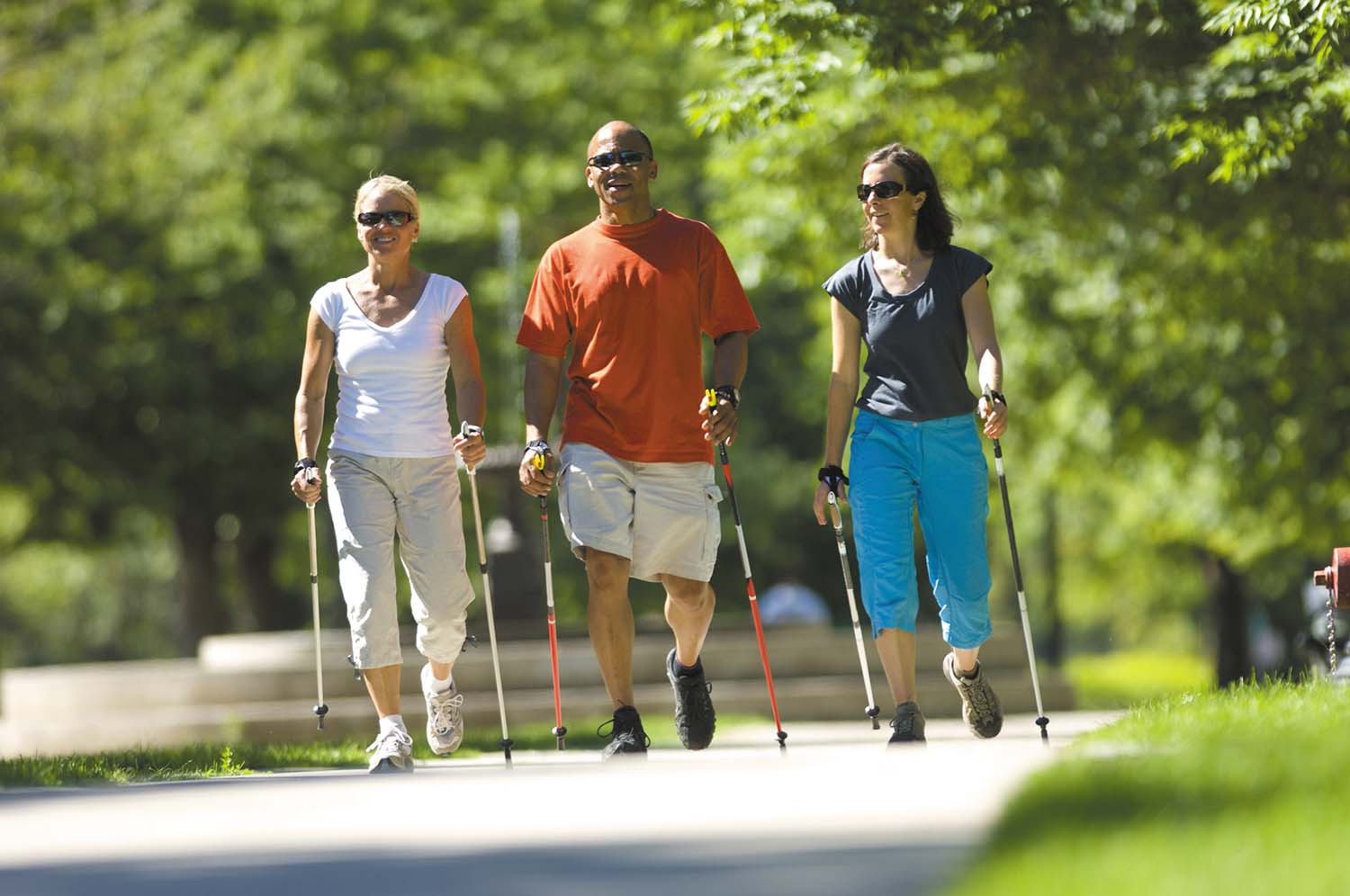Take a Nordic walk
This dynamic activity uses walking poles to help with support and increase intensity.
- Reviewed by Howard E. LeWine, MD, Chief Medical Editor, Harvard Health Publishing; Editorial Advisory Board Member, Harvard Health Publishing

Are you looking to ramp up your fitness walking routine or get back into exercise in a fun and safe way? Then pick up some poles and try Nordic walking.
Nordic walking mimics the motion of cross-country skiing by using poles to push yourself as you walk along. It originated in Finland in the early 20th century as a summer training routine for cross-country skiers. However, it is now a popular way to enjoy the benefits of walking while getting a full-body workout.
"With regular walking, you use about 50% to 70% of your muscles, but with Nordic, you use up to 80% to 90% by further engaging your arms, shoulders, back, and core," says Andrea Christoforou, a physical therapist and advanced clinician with Harvard-affiliated Spaulding Outpatient Center Cambridge.
Nordic walking can offer a higher-intensity workout than walking since you pump your arms using the poles. "The poles also help to propel you forward as you walk, which can increase walking speed and intensity," says Christoforou.
Multiple benefits
Nordic walking offers other benefits. Studies have shown that Nordic walking burns more calories than regular walking — estimates range from an increase of 18% to 67% — and may help lower "bad" LDL cholesterol levels.
A study published online on June 14, 2022, by the Canadian Journal of Cardiology found that people with heart disease who did Nordic walking two or three times a week for 12 weeks increased their endurance (as measured by a six-minute walking speed test) and reported greater quality of life and fewer depression symptoms than before they started the program.
Nordic walking is ideal for older adults as it can help improve mobility and balance. Using the poles forces you to take longer steps. This helps improve your walking stride and avoid a shuffling gait that can increase the risk of falls. Poles also help protect your lower-body joints. "When you walk with poles, the force of each stride is distributed through the poles — and less through the legs — which reduces the stress on your hips, knees, and feet," says Christoforou.
Picking poles
Unlike trekking or hiking poles, which have loose straps for your wrists, most Nordic poles come with a special glove-like system attached to each pole. You slide your hand into it and use your palm rather than your fingers to transmit power to the poles as you move forward.
You can find Nordic poles in sporting goods stores, outdoor stores, and online. The poles are available in lightweight aluminum or carbon material, with pointed tips for trails and rubber tips for sidewalks. The height of the poles can be adjusted. Ideally, a proper pole height is when your palm can cover the top of the pole when your forearm is held out at a 90° angle to your body. Christoforou suggests that you start by walking on level surfaces like your neighborhood sidewalks or walking paths. "As you become more experienced, venture onto nature trails with varying surfaces and inclines for more of a challenge."
Join the clubWhile you can enjoy the benefits of Nordic walking alone, it's sometimes fun to do it as a group activity. Check out local walking clubs and senior centers for group Nordic walking events. (For more information on Nordic walking and to view instructional videos, visit the American Nordic Walking Association website.) |
Walking workouts
There are two main Nordic walking techniques: single poling and double poling. Single poling mimics what your feet are doing, with just one pole in front of you for each stride. Do this either with the same-side arm and leg together or with the opposite arm and leg together. Double poling involves planting both poles symmetrically in front of you and pulling yourself forward as you walk three steps and then repeat.
If you are new to Nordic walking, you have any serious health issues, or you have recently recovered from an injury or surgery, get the okay from your doctor first. Christoforou suggests easing into Nordic walking workouts.
"If you normally do 20- to 30-minute walks, begin by using the poles only about 25% of the time," she says. "As you get comfortable with the walking rhythm, gradually increase the time you use the poles. Work up to two to three walking workouts a week, for 30 minutes to an hour each or longer if you are already used to walking more."
Image: © Scott Markewitz/Getty Images
About the Author

Matthew Solan, Executive Editor, Harvard Men's Health Watch
About the Reviewer

Howard E. LeWine, MD, Chief Medical Editor, Harvard Health Publishing; Editorial Advisory Board Member, Harvard Health Publishing
Disclaimer:
As a service to our readers, Harvard Health Publishing provides access to our library of archived content. Please note the date of last review or update on all articles.
No content on this site, regardless of date, should ever be used as a substitute for direct medical advice from your doctor or other qualified clinician.
















